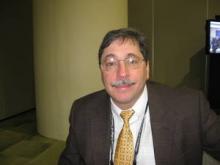SAN FRANCISCO – The annual meeting of the American College of Cardiology got off to a rocky start as the first late-breaking clinical trial in the opening plenary session – the eagerly anticipated PREVAIL study of the Watchman device for prevention of thromboembolic events in patients with atrial fibrillation – was removed from the program at the last minute because of a news embargo violation by the study sponsor. «Eds.: I’m dispensing with the Vitals because this is an unusual situation: we’re writing about data that wasn’t actually presented.--BJ»
A Boston Scientific employee triggered the ACC action by releasing PREVAIL results in an investors’ newsletter several hours before the study’s scheduled presentation by Dr. David R. Holmes Jr., professor of medicine at the Mayo Clinic in Rochester, Minn., and a former ACC president.
The Watchman device is an umbrella-like, self-expanding nitinol frame with anchors and a permeable fabric cover. It is deployed via a transseptal catheter-based approach. The device is designed to seal off the left atrial appendage to help prevent the estimated 80%-90% of strokes in patients with atrial fibrillation that are believed to be caused by emboli formed in the left atrial appendage.
PREVAIL (Prospective Randomized EVAluation of the Watchman left atrial appendage closure device In patients with atrial fibrillation versus Long-term warfarin therapy) had been expected to be a meeting highlight, given the Watchman’s potential as an alternative to lifelong oral anticoagulation. The study was conducted in response to a Food and Drug Administration request for additional safety data because of concerns raised in the earlier PROTECT AF trial.
In a recent update of the 707-patient PROTECT AF, the adverse event rate after a mean of 2.3 years of follow-up was 5.5 cases of major bleeding, pericardial effusion, or device embolization per 100 patient-years in the Watchman arm and 3.6 per 100 patient-years in the warfarin-treated control arm, for a 53% increase in risk with device therapy.
On the other hand, the primary treatment efficacy endpoint comprised of stroke, systemic embolization, or cardiovascular death occurred at a rate of 3 cases per 100 patient-years in the Watchman group compared to 4.3 per 100 patient-years in the control group, representing a 29% reduction in risk (Circulation 2013;127:720-9).
The PREVAIL trial involved 407 patients with atrial fibrillation who were randomized 2-to-1 at 41 U.S. centers to the Watchman device or warfarin therapy. Study investigators, denied the high-profile ACC forum, nonetheless made the data available.
The Watchman was implanted both by interventional cardiologists and electrophysiologists. As a result of procedural refinements, the implant success rate in PREVAIL was 95.1%, significantly better than the 90.9% rate in PROTECT AF. New operators had procedural success and complication rates similar to experienced ones.
PREVAIL featured multiple study endpoints. The primary safety endpoint, the 7-day composite rate of death, ischemic stroke, systemic embolism, or device-related complications requiring major interventions, was 2.2% in device recipients.
One efficacy endpoint, the 18-month combined rate of stroke, systemic embolism, or cardiovascular death, occurred at a rate of 0.064 cases per 100 patient-years in both study arms in PREVAIL. Despite the identical rates, this endpoint didn’t meet the statistical criterion for noninferiority.
Another efficacy endpoint, the rate of ischemic stroke or systemic embolism after 7 days and continuing out to 18 months, occurred at a rate of 0.025 cases per 100 patient-years in the Watchman group and 0.02 cases per 100 patient-years in controls, which did meet the noninferiority standard.
In an interview, American Heart Association immediate past-president Dr. Gordon Tomaselli, who was not involved in the Watchman trials, said he doesn’t think they establish a persuasive case for the device as an alternative to lifelong anticoagulation in the broad population of patients with atrial fibrillation.
“My prediction is the FDA device panel will probably recommend approval with a narrow indication: for patients who have a reason that they can’t be anticoagulated,” said Dr. Tomaselli, professor of medicine and chief of the division of cardiology at Johns Hopkins University, Baltimore.
He estimated that 5%-10% of patients with atrial fibrillation in his own practice fall into that category, either because they are at high bleeding risk or they have developed an embolism while on warfarin or another anticoagulant.
Dr. Tomaselli reported having no financial conflicts. Dr. Holmes has a financial interest in the Watchman technology.


